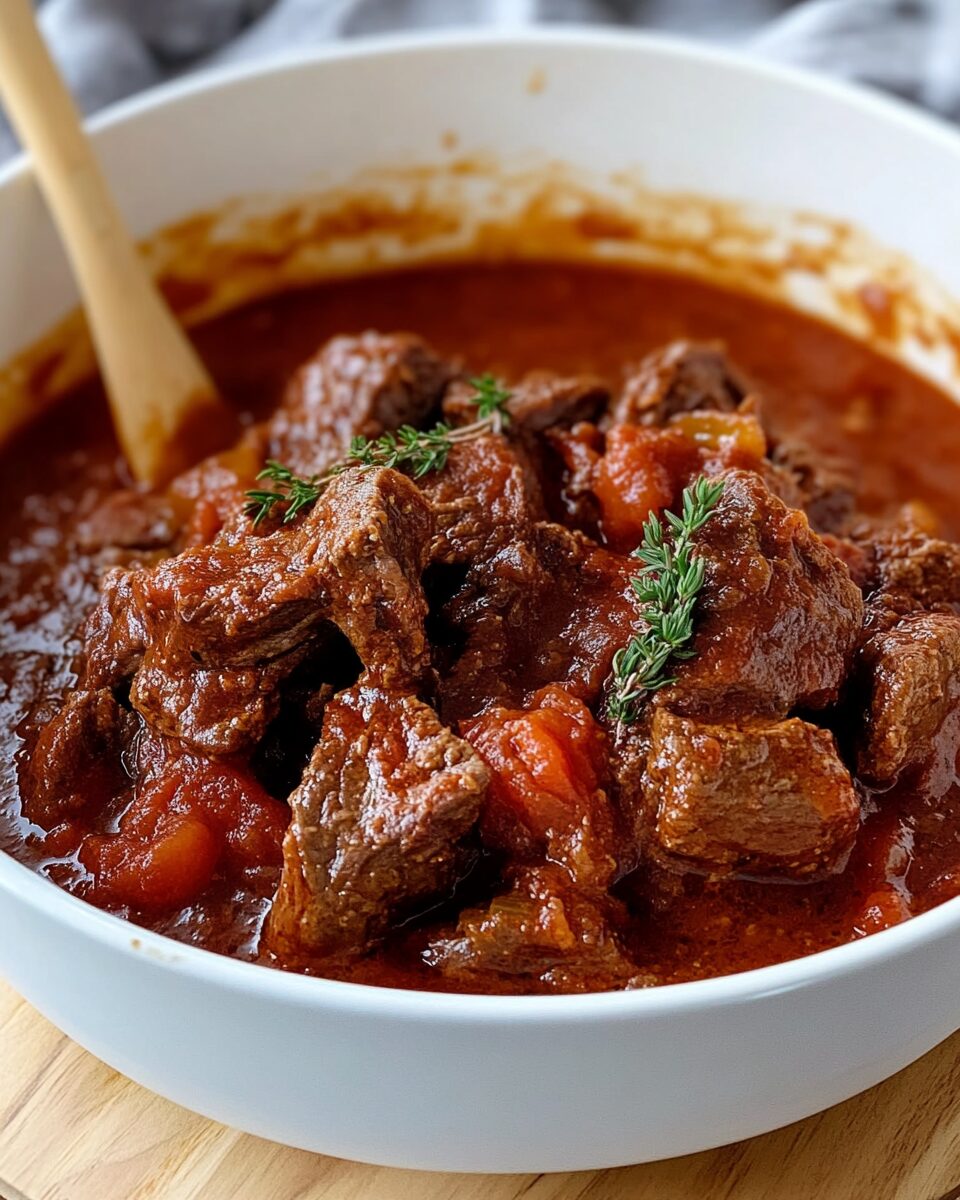The Roman-style stracotto is a dish that exemplifies the magic of slow cooking. This traditional Italian beef stew is simmered gently for hours in a flavorful blend of red wine, tomatoes, and aromatics, until the meat reaches a melt-in-your-mouth tenderness. The name “stracotto” literally means “overcooked” in Italian but in the best way possible. Deep, rich, and soul-warming, this dish hails from the heart of Roman cuisine and is often served over soft polenta or fresh pasta to soak up every last bit of its luscious sauce. It’s the kind of meal that brings everyone to the table, filling the kitchen with warmth, aroma, and memories. Ideal for Sunday family dinners or special gatherings, Stracotto alla Romana is a timeless celebration of rustic Italian flavors.
Full Recipe:
Ingredients:
-
2.5 lbs (1.2 kg) beef chuck roast, cut into large chunks
-
3 tablespoons extra virgin olive oil
-
1 medium onion, finely chopped
-
2 celery stalks, chopped
-
1 medium carrot, chopped
-
3 garlic cloves, minced
-
1 cup red wine (preferably dry)
-
2 cups crushed tomatoes (or passata)
-
2 tablespoons tomato paste
-
2 sprigs rosemary
-
2 bay leaves
-
Salt and freshly ground black pepper, to taste
-
1 cup beef broth or water (optional, for extra moisture)
Directions:
-
Heat the olive oil in a large heavy-bottomed pot over medium heat. Add the beef chunks and sear on all sides until browned. Remove and set aside.
-
In the same pot, add the chopped onion, carrot, and celery. Cook until softened and fragrant, about 5-7 minutes.
-
Add the minced garlic and cook for another minute, stirring frequently.
-
Pour in the red wine, scraping the bottom of the pot to release any browned bits. Let it simmer for 5 minutes to reduce slightly.
-
Stir in the tomato paste and crushed tomatoes. Mix well.
-
Return the seared beef to the pot. Add rosemary and bay leaves. Season with salt and pepper.
-
Cover and reduce the heat to low. Let it simmer gently for 3 to 4 hours, stirring occasionally. Add a splash of broth or water if it becomes too thick.
-
The beef should be incredibly tender and easily shreddable. Adjust seasoning before serving.
-
Serve hot over polenta, mashed potatoes, or fresh pasta for an authentic Roman experience.
Prep Time: 20 minutes | Cooking Time: 4 hours | Total Time: 4 hours 20 minutes
Kcal: 485 kcal per serving | Servings: 6
Stracotto alla Romana: A Deep Dive into Rome’s Comfort Classic
When we think of traditional Roman cuisine, images of pasta dishes like cacio e pepe or amatriciana often spring to mind. But among these icons is a less talked-about yet deeply comforting dish that holds a treasured place in Roman homes: Stracotto alla Romana, or Roman-style braised beef. This humble, slow-cooked stew transcends time and class, passed down from Italian grandmothers (nonnas) through generations and preserved today in rustic trattorias and home kitchens alike.
What Is Stracotto?
The term stracotto literally means “overcooked” in Italian, but don’t let that fool you. In this context, it’s not about overdoing the cooking it’s about slow cooking. In fact, “overcooked” here is synonymous with tenderness and flavor. It refers to meat that’s been simmered for hours in a robust tomato and wine sauce until it’s so soft it can be cut with a spoon.
Stracotto is a dish that spans many Italian regions, with slight variations in each one. However, Stracotto alla Romana is distinctly Roman in its use of bold, simple ingredients: beef, wine, tomatoes, aromatic herbs, and the classic Italian soffritto of onion, carrot, and celery. What sets it apart is the balance of earthiness and acidity thanks to the slow melding of beef and tomatoes over long cooking hours.
A Dish Rooted in Tradition
In the Roman countryside, slow-cooked dishes were the heart of the household. These meals weren’t meant to be fast they were designed to transform tough cuts of meat into luxurious, flavorful morsels with minimal ingredients. That philosophy reflects the broader tenets of cucina povera (poor man’s cuisine), where the focus is on making the most of every ingredient.
Stracotto often made its appearance on Sundays, religious holidays, or large family gatherings, cooked slowly on a wood-burning stove while the rest of the meal was prepared or while families returned from mass. It’s a dish that smells like childhood, evokes memories of warmth, and feels like home on a plate.
Culinary Technique: The Art of Braising
Stracotto is the quintessential braised dish. Braising is a two-step cooking technique that begins by searing meat to create a flavorful crust, followed by slow simmering in liquid usually a mix of wine, broth, or tomatoes until the meat is tender.
What’s magical about this process is the transformation that occurs over time. The meat fibers break down slowly, soaking up the flavors of the cooking liquid, herbs, and vegetables. The sauce thickens and concentrates, becoming a rich, velvety blend of umami, acid, and sweetness.
In Stracotto alla Romana, red wine is the key to that deep, bold base flavor. As it simmers, the wine’s acidity softens, and its natural sugars caramelize into the sauce. Combined with ripe tomatoes and the sweetness of carrots and onions, it creates a sauce that is rich without being heavy, luxurious without being complicated.
Choosing the Right Cut of Meat
The cut of beef used in this dish is crucial. Traditionally, Roman cooks opt for chuck roast or beef shoulder cuts that are inexpensive, flavorful, and perfect for braising. These cuts contain enough connective tissue and marbling to become buttery-soft when cooked low and slow.
Avoid lean cuts like sirloin or tenderloin, which may dry out during long cooking. In fact, the success of stracotto lies in its use of so-called “tough” cuts, which shine when treated with patience and care.
Pairing and Serving Ideas
One of the most delightful aspects of Stracotto alla Romana is its versatility in pairing. In Rome, it’s often served atop a bed of soft polenta, whose creamy texture contrasts beautifully with the meaty stew. It’s also common to serve it with fresh egg pasta, especially pappardelle or fettuccine, allowing the wide ribbons to soak up every drop of sauce.
Other options include:
-
Mashed potatoes – for a more Northern Italian feel.
-
Crusty rustic bread – perfect for sopping up the remaining sauce.
-
Roasted root vegetables – complement the sweetness of the tomato-wine braise.
As for wine pairing, a robust red wine such as Chianti, Montepulciano, or Barolo pairs wonderfully with the dish. The wine in the glass should echo the depth of the wine in the sauce, creating a harmonious experience from start to finish.
Make It Ahead: Even Better the Next Day
One of the best secrets of Stracotto alla Romana is that it improves with time. Like many braised dishes, the flavors intensify and meld after sitting overnight. Making it a day ahead not only saves time during a dinner party but also elevates the taste.
To reheat, simply bring it back to a gentle simmer on the stovetop, adding a splash of water or broth if needed. The beef will be just as tender, and the sauce even richer.
Cultural Context: A Symbol of Patience and Hospitality
In Roman culture, cooking stracotto is a gesture of love. It’s a dish that requires time, attention, and planning not the kind of thing you throw together after work. Serving stracotto tells guests, “You were worth the wait.”
It also reflects a deeply Italian approach to food: respect for tradition, celebration of simple ingredients, and the understanding that the best meals are often the slowest to prepare. In many Roman homes, stracotto is a rite of passage something a child first watches their grandmother make, then learns to cook themselves as a symbol of adulthood and heritage.
A Homestyle Classic in Modern Kitchens
While it may sound old-fashioned, Stracotto alla Romana is experiencing a resurgence in modern kitchens. The rise of slow cookers, Dutch ovens, and Instant Pots means that busy home cooks can now prepare this rustic dish with greater ease than ever before.
Yet the soul of the dish remains unchanged. Whether cooked in a clay pot over wood or in a cast-iron Dutch oven on an induction stove, what matters most is the slow, steady transformation that only time can deliver.
Home chefs love stracotto because it allows them to practice mindfulness in cooking. It teaches patience, rewards planning, and produces a result that feels like a hug from an Italian grandmother even if you’ve never had one.
Conclusion:
Stracotto alla Romana is more than a dish it’s a culinary time capsule that preserves the flavors and traditions of ancient Rome in a way that’s both accessible and deeply satisfying. It’s a reminder that the best meals aren’t rushed, and that cooking is as much about the process as it is the result.
By embracing the humble ingredients and allowing them to transform through slow, loving preparation, you unlock a meal that’s worthy of any Sunday dinner, holiday celebration, or intimate evening at home.

